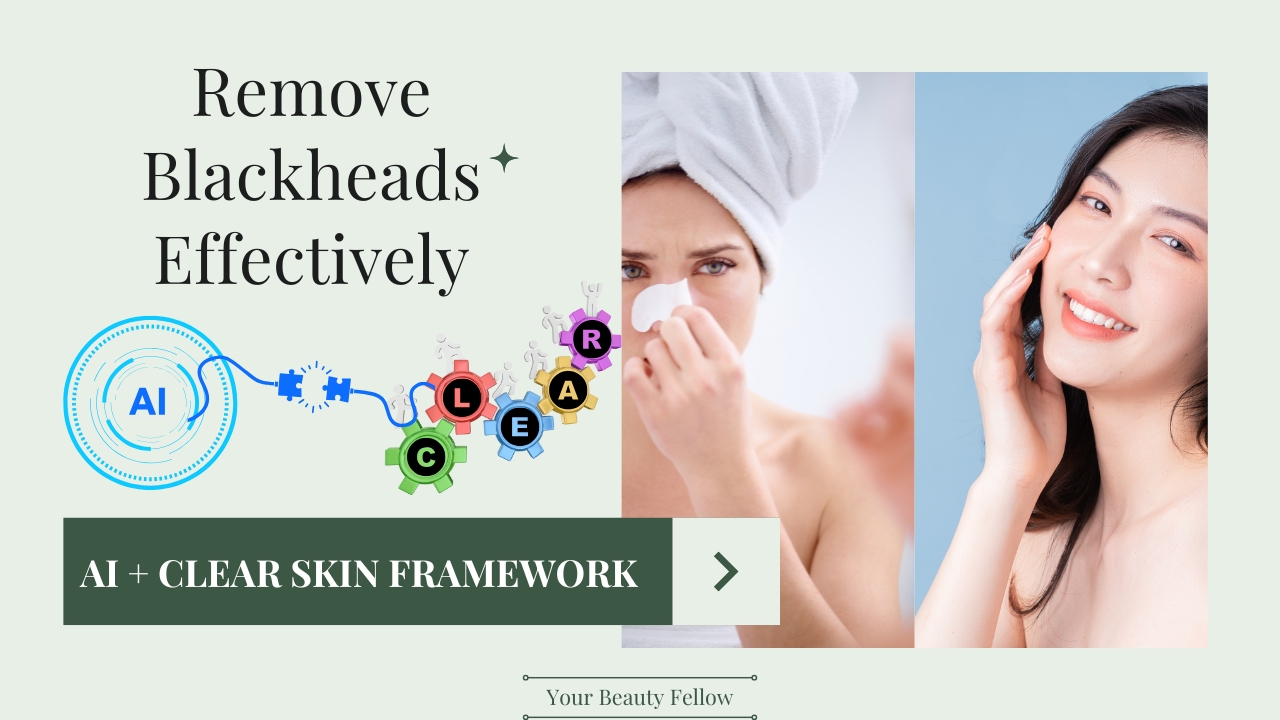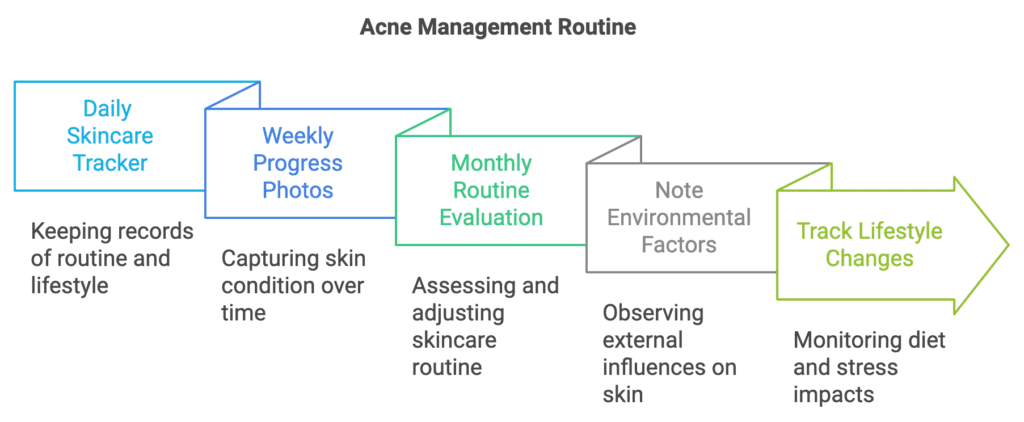
If you’ve struggled with blackheads, you’re not alone. Over 60 million people deal with this common skin issue. While blackheads can feel frustrating, achieving clear skin is entirely possible with the right knowledge and approach.
In this guide, we’ll combine the power of AI tools and the CLEAR Skin Framework to help you develop a personalised plan to eliminate blackheads and maintain healthy skin. AI tools can assist in creating tailored routines and tracking product effectiveness, while the CLEAR Skin Framework provides a step-by-step strategy to systematically target blackhead removal.
What Are Blackheads?
Blackheads, or open comedones, are a type of non-inflammatory acne that forms when hair follicles become clogged with oil, dead skin cells, and debris. Exposure to air oxidises the clogged material, turning it black. Unlike pimples, blackheads aren’t caused by bacteria, so they don’t typically swell or turn red.
Myth Debunked: Blackheads are not caused by dirt. Even with regular cleansing, they can appear if other factors like excess oil or dead skin buildup aren’t addressed.
What Causes Blackheads?
To treat blackheads effectively, it’s crucial to address their root causes. These include:
1. Excess Oil (Sebum) Production:
Overactive sebaceous glands produce too much oil, mixing with dead skin cells to clog pores.
2. Dead Skin Buildup:
The natural skin renewal process slows down due to age, stress, or hormonal changes, leading to an accumulation of dead skin cells.
3. Other Contributing Factors:
- Hormonal changes (e.g., puberty, menstruation)
- A high-glycemic diet rich in sugar and refined carbs
- Stress and lack of sleep
- Comedogenic (pore-clogging) skincare or makeup products
How to Remove Blackheads
Removing blackheads requires a targeted approach to unclog pores and regulate oil production. Follow this dermatologist-approved step-by-step guide for effective blackhead removal:
1. Gentle Cleansing
Proper cleansing removes oil, dirt, and debris without stripping the skin.
- Use a Non-Comedogenic Cleanser: Look for a low-pH (around 5.5) cleanser with active ingredients like salicylic acid (BHA) or niacinamide.
- Double-Cleansing for Makeup or Sunscreen Users: Start with an oil-based cleanser to dissolve makeup or sunscreen, followed by a water-based cleanser.
- Tips: Wash your face twice daily with lukewarm water. Avoid harsh scrubbing to prevent irritation.
2. Exfoliate to Remove Dead Skin
Exfoliation clears clogged pores and improves skin texture.
- Chemical Exfoliants (Preferred): Use salicylic acid (BHA) or glycolic acid (AHA) to gently dissolve buildup in pores.
- Start Slowly: Begin with once or twice a week and increase as your skin adjusts. Over-exfoliation can damage your skin barrier.
3. Targeted Treatments
Incorporate these powerful solutions for stubborn blackheads:
- Retinoids: Boost cell turnover to prevent clogged pores. Start with a low concentration (e.g., retinol 0.25% or adapalene 0.1%).
- Weekly Clay Masks: Clay masks absorb excess oil and clear impurities. Use on blackhead-prone areas like the nose and chin.
- Professional Treatments: For severe blackheads, consult a dermatologist for chemical peels, microdermabrasion, or manual extractions.
Daily Skincare Routine for Blackhead Removal:
Morning Routine
Evening Routine
How to Prevent Blackheads
Consistency is key to keeping blackheads at bay. Follow these tips:
1. Avoid Squeezing Blackheads: Manual squeezing can push impurities deeper into the skin, causing inflammation.
2. Use Non-Comedogenic Products: Choose lightweight, water-based skincare and makeup labeled as “non-comedogenic.”
3. Stay Hydrated: Proper hydration balances oil production and prevents clogged pores.
4. Maintain a Balanced Diet: Reduce high-glycemic foods to minimise oil production.
5. Stick to Your Routine: Track your progress with a skincare journal to identify what works best.
Common Mistakes and How to Avoid Them
- Using Harsh Products: Overly strong cleansers or exfoliants can strip your skin, increasing oil production.
- Frequent Product Switching: Give products at least 4-6 weeks to show results.
- Skipping Sunscreen: UV exposure worsens skin issues and reduces the effectiveness of treatments like retinoids.
How AI Tools Can Help Identify and Treat Blackheads
AI-powered skincare tools simplify the process for those new to skincare or overwhelmed by ingredient choices. Here’s how they help:

1. Personalised Routine Creation: AI tools analyse your skin type, concerns, and product preferences to recommend tailored anti-blackhead solutions, such as cleansers with salicylic acid or exfoliants with glycolic acid.
2. Ingredient Analysis: Unsure if a product is right for you? AI tools provide insights on active ingredients, helping you select effective and non-comedogenic options.
3. Tracking Progress: AI apps allow you to monitor changes in your skin over weeks or months, identifying which products deliver results and which to replace.
Integrating these tools into your skincare journey ensures a smarter and more efficient approach to tackling blackheads.
Using the CLEAR Skin Framework to Remove Blackheads
The CLEAR Skin Framework provides a structured, evidence-based approach to achieving your skin goals. Let’s break it down:

1. Classify Your Skin Type
Understanding your skin type is essential. AI skin scanners can analyse your skin, identifying oil levels, pore size, and sensitivity. Knowing whether you have oily, dry, or combination skin will guide your product choices.
2. Learn Your Skin Needs
Pinpoint the root causes of blackheads. For example, do you struggle with excess oil production, or is your skin barrier compromised? AI tools can highlight specific problem areas and recommend ingredients like salicylic acid for deep pore cleansing or niacinamide to regulate oil.
3. Establish SMART Skin Goals
Set Specific, Measurable, Achievable, Relevant, and Time-bound goals. Example: “Reduce blackheads on the nose by 50% in 8 weeks using a salicylic acid cleanser and retinoid treatment.” AI tools can help monitor progress, ensuring you stay on track.
4. Assemble a Personalised Skincare Routine
Create a routine with targeted products and active ingredients (refer to skincare routine above). AI tools can refine this routine by recommending products based on your skin’s progress.
5. Review and Track Your Progress
Consistency is key to achieving lasting results. Use AI tools to photograph your skin weekly, track changes, and adjust your routine as needed. If a product isn’t working or is causing irritation, the AI will suggest alternatives.
How AI Tools and CLEAR Framework Work Together
The CLEAR Skin Framework provides a step-by-step roadmap to remove blackheads, while AI tools enhance each step by personalizing recommendations and tracking progress. Here’s an example:
1. AI identifies your skin type and suggests a salicylic acid cleanser that works best for you.
2. CLEAR Framework guides you to layer actives effectively while maintaining hydration.
3. AI tracks your skin’s response, ensuring adjustments (like introducing retinoids) are timely and effective.
Together, they simplify skincare, empowering you to achieve clear, healthy skin with confidence.
With patience, consistency, and the right strategies, you can achieve blackhead-free skin. By incorporating AI-powered tools and the CLEAR Skin Framework, you’ll not only remove blackheads but also develop a long-term plan for healthier, glowing skin.
Here’s to your journey to clear skin—one step at a time!
Frequently Asked Questions
How Long Does It Typically Take to See Results When Treating Blackheads?
Most people start seeing noticeable improvements in blackhead reduction within 4-6 weeks of consistent skincare routine. However, complete clearance can take 2-3 months. AI tools can help track your progress, providing objective measurements of skin changes. Patience and consistency are key—stick to your personalised routine, and don’t get discouraged if results aren’t immediate.
Are Blackhead Removal Strips Safe to Use?
While blackhead strips can provide temporary cosmetic relief, they’re not a long-term solution. These strips can potentially damage your skin’s protective barrier and cause irritation. Instead, focus on a comprehensive skincare routine that addresses root causes. Chemical exfoliants like salicylic acid and consistent cleansing are more effective and gentler approaches to blackhead management.
Can Diet Really Impact Blackhead Formation?
Absolutely. Diet plays a significant role in skin health and blackhead formation. High-glycemic foods and dairy can trigger increased oil production and inflammation. Foods rich in zinc, omega-3 fatty acids, and antioxidants can help regulate sebum production and support skin health. AI tools can help track potential dietary connections to your skin’s condition.
Do Blackheads Mean I Have Oily Skin?
Not necessarily. Blackheads can occur in all skin types—oily, combination, and even dry skin. They’re caused by a combination of factors including dead skin cell buildup, excess oil, and pore-clogging products. AI skin analysis tools can help you understand your precise skin type and identify the specific factors contributing to your blackheads.
How Do Hormones Affect Blackhead Formation?
Hormonal changes significantly impact blackhead development. Fluctuations during puberty, menstruation, pregnancy, and stress can increase sebum production, leading to more frequent blackheads. Hormonal imbalances can cause increased oil production and slower skin cell turnover. AI tools can help you track these patterns and adjust your skincare routine accordingly.
Are Natural Remedies Effective for Blackhead Removal?
While some natural remedies like clay masks or tea tree oil can help manage blackheads, they’re not as consistently effective as scientifically formulated treatments. Professional skincare products with active ingredients like salicylic acid, niacinamide, and retinoids offer more targeted and proven results. AI tools can help you identify the most effective ingredients for your specific skin concerns.
Can AI Skin Analysis Really Help with Blackhead Removal?
AI skin analysis tools provide valuable insights by accurately assessing your skin type, identifying potential triggers, and recommending personalised treatments. They can track progress, suggest product combinations, and help you understand your skin’s unique characteristics. While not a complete replacement for professional dermatological advice, these tools offer a data-driven approach to managing blackheads.






